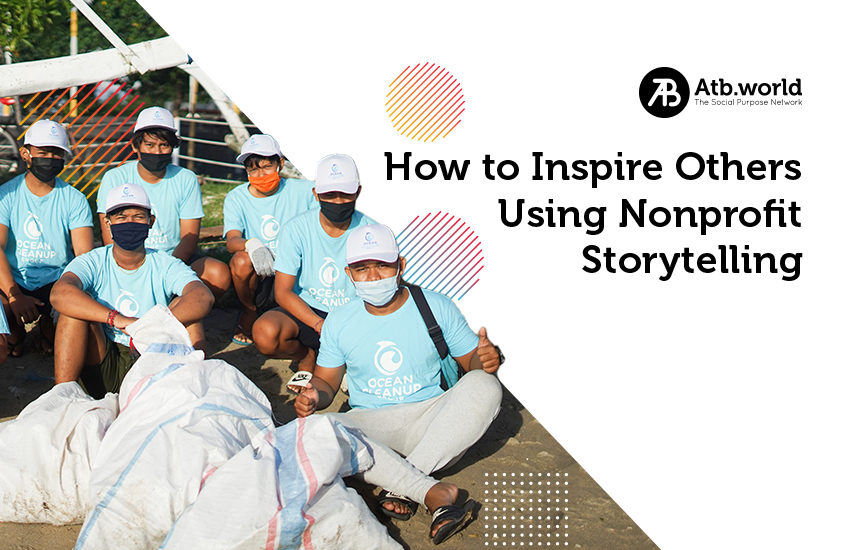Do you know that by using nonprofit storytelling, you can inspire others? But you may ask, is nonprofit storytelling different from simple storytelling. The answer is yes. For nonprofit storytelling, real people share their real stories and how they made an impact, while storytelling can be a fictional story and need not have created an impact.
Many nonprofit organisations and social purpose platforms like Atb.world use nonprofit storytelling to engage with the audience, inspire others to join causes they support, and create social impact.
Before we talk about how to inspire others using nonprofit storytelling, let us first understand why there is a need for nonprofit storytelling.
What is the Need for Nonprofit Storytelling?
Fictional stories may be engaging, but they can’t pack emotions as powerfully as real-life stories. But, on the other hand, real stories have the power to make people feel something, forcing them to think about how they can contribute towards causes or organisations that they support.
Furthermore, sharing one real story will be more impactful than sharing accounts of unnamed people or sharing researches from leading experts. A real account by an individual told using nonprofit storytelling can help people understand the cause and may encourage them to donate. It can also help raise awareness about important issues that prevail in our society. If storytellers talk about the violence they experienced and how they emerged from it stronger, it can be a healing and empowering experience for them.
Now, let’s talk about how to inspire others using nonprofit storytelling.
How to Inspire Others With the help of Nonprofit Storytelling
Tell Your Story Yourself
Nothing will be as powerful as you telling your own story. Think about it. You have read an article where the nonprofit talks about how they are making a difference. In another one, you see the person whose life is impacted by an NGO. That person was the one talking about his experience. Which one do you think will evoke emotions? The answer is quite obvious, the latter one.
For example, this story by Habitat for Humanity talks about 81-year-old Walter. It is one of the best storytelling examples. He had no bathroom in his house, and Habitat for Humanity got one built for him. The story talks about Walter and his life, and we as readers are immediately pulled by it. We become heavily invested in Walter’sWalter’s story. We get to know about his childhood, his profession and are happy to know that he finally got a bathroom to shower in.
If you have a story that you believe can impact others, bring social change, and encourage others to share theirs, share it. You can use Atb.world- our social purpose platform for nonprofit storytelling.
You Made a Difference? Show the Impact that it Made
Okay, so you have a great story about how you helped a cause or organisation. Now what? When telling your story, show the impact it made. How your help has made a difference and what were the challenges you overcame.
Talking about these things in detail will help other people understand that if your help can make a difference, so can theirs. It will encourage others to donate to causes they support or tell their story if they have one. By reading your impact story, other people will also get inspiration to do better for the people in need.
Provide Details
If you tell your story, give details about your journey, what you are trying to achieve, what obstacles you faced, etc. Someone with a similar journey may feel connected with your story. Establishing a connection is important, and with nonprofit storytelling, you can do just that.
Give Social Proof
If you are telling a story about a cause you support, provide social proof in the form of images and video. For example, Kilroy Foundation here talks about helping reconstruct a school in Nepal that got affected by the earthquake that hit the country in 2015. They provided the images start from the beginning of the reconstruction of the school to its completion.
Providing social proof helps people understand that your cause is genuine, and if they donate to your cause, their money will go in the right direction.
Nonprofit Storytelling Strategies
For nonprofit storytelling, there are some strategies that you can use.
- Scared to come forward to share your story? Don’t be.
- Make a rough note of what you want to say and how you want to say it.
- Use your emotions and help people understand things from your perspective.
- Be straight to the point and never beat around the bush.
Final Words: Now that you know how to inspire others using nonprofit storytelling, share your story using Atb.world. If you are new to Atb.world, sign in as an individual or organisation and share your story with the world.

